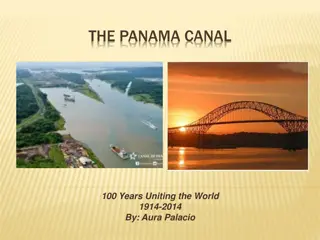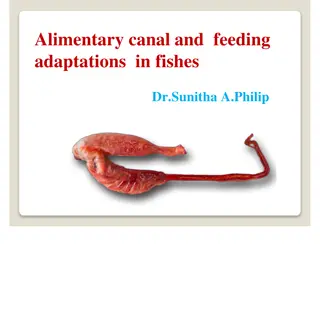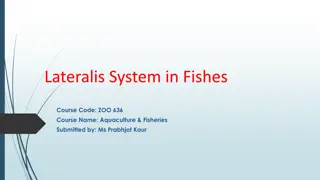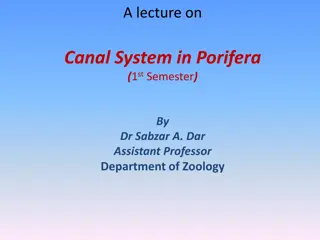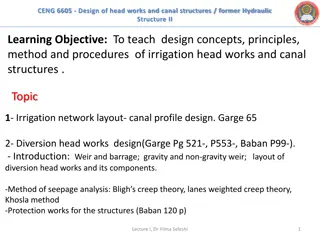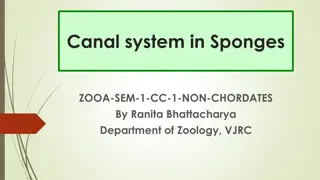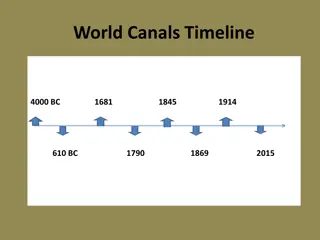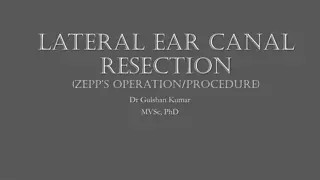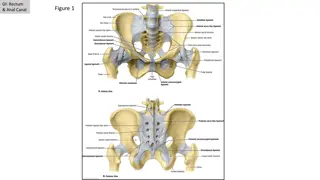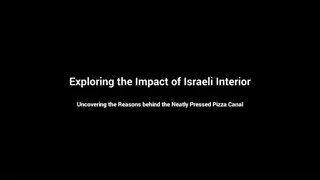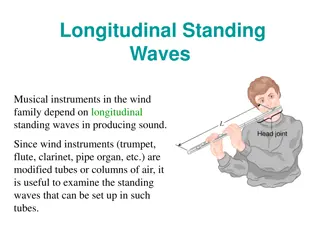History and Significance of the Suez Canal: A Journey Through Time
The Suez Canal, connecting the Mediterranean and Red Seas, has played a crucial role in global maritime trade since its completion in 1869. This waterway, constructed with significant engineering efforts, has seen transitions of ownership and control over the years. From the British intervention to its strategic importance during WWI, the canal has shaped trade routes and geopolitical dynamics. Explore the impact, construction, and complexities surrounding this vital maritime artery.
Download Presentation

Please find below an Image/Link to download the presentation.
The content on the website is provided AS IS for your information and personal use only. It may not be sold, licensed, or shared on other websites without obtaining consent from the author. Download presentation by click this link. If you encounter any issues during the download, it is possible that the publisher has removed the file from their server.
E N D
Presentation Transcript
The Suez Canal Benjamin Porat Period 3
Introduction The Suez Canal connects the Mediterranean and Red Seas. It became a critical passage for ships travelling between Britain and India. In 1854, Ferdinand Lesseps (French) secured an agreement with the Ottoman governor of Egypt to build the 100 mile canal across the Isthmus of Suez. In 1856, the Suez Canal Company was formed to operate the canal for 99 years following completion of construction. The canal
Construction of the Canal Construction began April, 1859 At first, forced-laborers with picks and shovels did the work. Later, Europeans with dredgers and steam shovels arrived. Labor disputes and a cholera outbreak delayed the project. The canal was finished in 1869 and opened on November 17th, 1869 four years late. It was 25 feet deep and 200-300 feet wide. Only 500 ships travelled through it the first year it was opened. Today about 17,000 ships travel through it every year.
What is a Dredger and a Steam Shovel? A dredger A dredger is a tool designed to remove sediment and debris from the bottom of a lake, harbor, or canal to prevent accumulation or to increase the depth of a canal. A steam shovel is a machine that uses steam to dig. It works much more efficiently and quickly than a human can. It is similar in appearance to a tractor. Teddy Roosevelt In a steam shovel (Panama)
The British Take Control of the Canal The Khedive (Governor) of Egypt was heavily indebted in 1875. Benjamin Disraeli, British Prime Minister borrowed 4,000,000 from the Rothschild Family to buy a controlling stake of the canal. Disraeli borrowed the money because Parliament was not in session. He faced severe criticism, however, Queen Victoria supported him. This move allowed Britain to take greater control over Egypt. Benjamin Disraeli
Benefits of the Canal to Britain Distance from listed port to London Ports Distance by Cape Distance by Canal Miles Saved by Canal Percent of Voyage Saved by Canal Bombay 10,667 6,274 4,393 41.2 Madras 11,280 7,313 3,967 35.2 Calcutta 11,900 8,083 3,817 32.1 Singapore 11,740 8,362 3,378 28.8 Hong Kong 13,180 9,799 3,381 25.6 Shanghai 14,050 10,669 3,381 24.1 Adelaide 11,780 11,100 680 5.8 Melbourne 12,140 11,585 555 4.6 Sydney 12,690 12,145 545 4.3 Wellington 13,610 13,055 555 4.1
The Canal During WWI Britain controlled Egypt in 1914, however, it technically belonged to the Ottoman Empire. Britain was an allied power and Turkey was a Central Power. On February 3rd, 1915, the Turks attacked the Suez Canal. 70,000 British troops, mostly Indian, defended the canal. The Turks suffered 1,500 casualties and retreated. vs
The Suez Canal During WWII The British used the canal as a life-line between itself and its colonies. The Germans hoped to capture it and use it as a launching point into the Middle East for its oil. The closest the Axis Powers got to it was at El Alamein.
The Suez Crisis Started on September 15th, 1956 when Gamel Nasser nationalized the Suez Canal. This meant that the Canal was under the control of the Egyptian Government. This fit into Nasser s socialist and nationalist ideology. The problem was that this event occurred 12 years before the Suez Canal Company s contract expired. France, Britain, and Israel sought to recapture the canal by force. The USSR and USA disapproved of military action and sought to mediate the problem.
Leaders during the Suez Crisis Gamal Nasser, President of Egypt Had an Arab-Nationalist identity and often said to be the first regional leader to challenge Western dominance of the region. He supported the USSR in retaliation for US support of Israel. Anthony Eden, Prime Minister of Great Britain Member of the Conservative Party and succeeded Winston Churchill. He was previously Foreign Minister multiple times. He became infamous for his disastrous handling of the Suez Crisis and subsequently resigned. Rene Coty, President of France Member of the National Centre of Independents and Peasants party, a center-right party in France. He was the last leader of the French Fourth Republic. David Ben-Gurion, Prime Minister of Israel First leader of Israel, starting from its independence in 1948.He was the leader of Mapai, a communist/socialist party that dominated Israel at the time. He was also known for his Zionist ideology- the belief that the Jewish people should have a homeland in Israel. Nasser Eden Ben-Gurion Coty
The Crisis Intensifies On October 29, 1956, Israeli troops invaded the Sinai Canal. British and French forces quickly came to support them. These forces quickly took control of the canal, with hesitation, allowing the Soviet Union time to deal with the Hungarian crisis. Khrushchev supported Egypt and threatened nuclear war. Eisenhower warned both the USSR and Anglo-French- Israeli coalition to cease hostilities. Eisenhower felt betrayed since he was not notified in advance. Britain and France withdrew in December; Israel in March 1957. Eisenhower had threatened sanctions.
The Aftermath This event is attributed to ending Britain s role as a superpower and diminishing French prestige. In Israel, Ben-Gurion s Mapai party increased its dominance in the elections of 1959. Tensions remained high between Egypt and Israel, culminating in the Six-Day War in 1967. PM Eden resigned as a result of the fiasco. One year later, Coty would resign and the French Fifth Republic was formed.
The Suez Canal 1957 - Today After the Six-Day War in 1967, the Canal was closed until the Camp David Accords in 1978 which brought peace between Israel and Egypt. Today the canal serves about 17,000 ships per year. Traffic through the canal has had the uncanny ability of mirroring World GDP growth.
Works Cited "Anthony Eden (1897 - 1977)." BBC News. BBC, n.d. Web. 19 Mar. 2014. Baker, Chris. "The First Turkish Attack on the Suez Canal."The Long, Long Trail.N.p., n.d. Web. 09 Mar. 2014. <http://www.1914-1918.net/suez.htm>. Barrow, Mandy. "British Flag - The Union Jack (Union Flag) UK." British Life & Culture. Project Britain, n.d. Web. 17 Mar. 2014. "Canal History."Suez Canal Authority.Government of Egypt, n.d. Web. 4 Mar. 2014. "Disraeli." PBS. PBS, n.d. Web. 19 Mar. 2014. "File:Flag of the Ottoman Empire.svg." - Wikimedia Commons. N.p., 2009. Web. 19 Mar. 2014. "From the Archives: U.S. President Theodore Roosevelt Poses with a Steam Shovel." New & Used Farm & Mining Equipment. N.p., 14 Aug. 2012. Web. 19 Mar. 2014. "Gamal Abdel Nasser." History Learning Site. Weider History Group, n.d. Web. 18 Mar. 2014. History.com Staff. "Suez Crisis." History.com. A&E Television Networks, 2009. Web.
Works Cited McIntyre, Douglas A. "The Suez Canal by the Numbers: Ship Attack Raises Risk." 24/7 Wall Street. 24/7, 2 Sept. 2013. Web. 11 Mar. 2014. Nasser, Gamal A. "Modern History Sourcebook: President Nasser: Denouncement of the Proposal for a Canal Users' Association, 1956." Fordham.edu. Fordham University, July "North Africa & Italy Atlas." Sword Beach. N.p., n.d. Web. 18 Mar. 2014. Park, Joseph Hendershot. British Prime Ministers of the Nineteenth Century: Policies and Speeches. New York: New York University Press, 1916, pp. 237-244.. Parker, Akweli. "How Steam Shovels Work." HowStuffWorks. HowStuffWorks.com, 26 Apr. 2011. Web. 19 Mar. 2014. 1998. Web. 10 Mar. 2014. Rabino, Joseph. 1887. The Statistical Story of the Suez Canal, Journal of the Royal Statistical Society 50 (3) (Sep.): pp. 495-546. Sichko, Christopher T. "The Influence of the Suez Canal on Steam Navigation." Diss. University of Colorado Boulder, 2011.Colorado State University. University of Colorado, 5 Apr. 2 011. Web. 4 Mar. 2014. "Suez Canal Opens." History.com. A&E Television Networks, n.d. Web. 19 Mar. 2014. "Suez Canal Shares."The Victorian Web.N.p., n.d. Web. 9 Mar. 2014. <http://www.victorianweb.org/history/polspeech/suez.html>. "SUEZ CANAL TRAFFIC AS TRADE INDICATOR PROBLEMATIC."Marginal Evolution. Apr. 2012. Web. 11 Mar. 2014. N.p., 22
Works Cited The Editors of Encyclop dia Britannica. "Rene Coty (president of France)." Encyclopedia Britannica Online. Encyclopedia Britannica, n.d. Web. 19 Mar. 2014. United States. State Department. Embassy in London. Telegram From the Embassy in the United Kingdom to the Department of State. N.p.: n.p., n.d. US Deptarment of State Office of the Historian. US State Department. Web. 10 Mar. 2014. United States. US State Department. Embassy in Cairo.Telegram From the Embassy in Egypt to the Department of State. N.p.: n.p., n.d.US Deptarment of State Office of the Historian. US State Department. Web. 11 Mar. 2014. United States. US State Department. Message From Prime Minister Ben Gurion to President Eisenhower. By David Ben Gurion. N.p.: n.p., n.d.US Deptarment of State Office of the Historian. US State Department. Web. 11 Mar. 2014. United States. US State Department. Message From the President to the Secretary of State. By Dwight D. Eisenhower. Augusta: n.p., 1956.US Deptarment of State Office of the Historian. US State Department. Web. 11 Mar. 2014. United States. US State Department. US Army. Memorandum of a Conference With the President, White House, Washington, July 27, 1956, 8:30 A.m. N.p.: n.p., n.d.US Deptarment of State Office of the Historian. US State Department. Web. 10 Mar. 2014. W. & A. K. Ltd. World on Mercator's Projection.Map.N.p.: n.p., 1914. Print. Popular American Edition. "What Is Dredging?" National Ocean Service. National Oceanic and Atmospheric Administration, n.d. Web. 19 Mar. 2014. "World War II: North Africa Campaign." History Net. Weider History Group, 12 June 2006. Web. 19 Mar. 2014.




